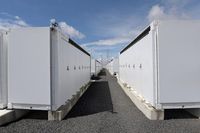In recent years, the world has witnessed an extraordinary surge in the construction and expansion of data centers, a phenomenon driven primarily by the exponential growth of artificial intelligence (AI) and the corresponding need for vast computing power. This boom is not just reshaping the technology sector—it’s fundamentally altering the global energy landscape, creating new opportunities for investors, and raising difficult questions about environmental sustainability and community impact.
Take a walk through any modern data center, like the one in Piscataway, New Jersey, and you’ll quickly realize the scale of what’s happening. Rows upon rows of seven-foot-high server racks hum with activity, gobbling up electricity to keep the digital world running. According to CNET, a single facility like this can support up to 3 megawatts of power—enough to supply hundreds of homes. But this is just the tip of the iceberg. Across the United States, data centers are becoming larger and more numerous, driven by the insatiable demands of AI applications such as ChatGPT, which now boasts nearly 700 million active users each week and five million paying business users.
Big Tech is leading the charge. Meta, for example, is investing $10 billion in its Hyperion data center in Louisiana, a massive 4-million-square-foot facility slated to open by 2030. In Pennsylvania, the AI infrastructure race has attracted more than $90 billion in investments, including $25 billion from Google alone, according to CNET. Meanwhile, the Stargate Project—a collaboration between OpenAI, Oracle, Softbank, and others—plans to pour $500 billion into AI infrastructure over the next four years, with an early flagship data center under construction in Abilene, Texas. This single facility will eventually require 1.2 gigawatts of electricity, enough to power 750,000 homes.
The power requirements of these new data centers are staggering. The International Energy Agency reports that the United States accounted for 45% of global data center electricity consumption in 2024. The Department of Energy warns that AI data centers are now a key driver of electricity demand growth, with the number of US data centers nearly doubling from 2021 to 2024. By 2035, electricity demand from data centers is expected to double compared with today, and Microsoft President Brad Smith has estimated that the country will need to recruit and train half a million new electricians over the next decade just to keep up.
This surge in demand is not unique to the US. Australia, for instance, recently became the world’s third-largest market for big batteries by installed capacity, overtaking the UK, according to Bloomberg. Utility-scale battery power in Australia is expected to increase eightfold by 2035, a transformation driven by the retirement of coal plants and the need to store and distribute electricity more efficiently. Battery investors are capitalizing on Australia’s notoriously volatile power prices, buying electricity when it’s cheap and selling it when prices spike.
The infrastructure boom is global and massive. The Deloitte 2025 AI Infrastructure Survey, cited by AInvest, found that 79% of executives expect AI to increase power demand through 2035. Utilities are responding by increasing capital expenditures by 22% in 2025 alone, reaching a projected $212 billion, while hyperscalers—giant tech companies—are expected to spend $371 billion on AI infrastructure this year. Renewables and battery storage account for 92% of planned generating capacity additions in 2025, highlighting a shift toward cleaner energy sources even as overall demand soars.
Yet, not every sector is benefitting equally from these seismic shifts. Traditional consumer staples companies like Brown-Forman, the spirits giant behind Jack Daniel’s, are feeling the pressure. As reported by AInvest, Brown-Forman’s Q2 2025 earnings showed a 7.3% revenue decline and a miss on earnings per share. The company’s 71.05% debt-to-equity ratio and a 2.98% dividend yield, unsupported by free cash flow, underscore its precarious position. Analysts project only 3.33% EPS growth over the next year, and the consensus price target of $31.44 reflects skepticism about the company’s ability to reverse its fortunes. Even as Brown-Forman invests in digital transformation—think virtual tastings and AI-driven marketing—the scale simply cannot compete with the capital intensity and growth trajectories of the AI and energy sectors.
“The stock market is a theater of competing narratives,” AInvest observes. “On one side, traditional consumer staples like Brown-Forman cling to their legacy of premium brand equity and dividend yields. On the other, AI and energy infrastructure sectors surge forward with exponential growth projections, reshaping the economic landscape.” For investors, the message is clear: selling Brown-Forman stock and reallocating to AI and energy infrastructure offers a more compelling risk-reward profile.
But as the AI and energy arms race accelerates, it’s not without consequences. The environmental impact of data centers is coming under increasing scrutiny. Data centers require vast quantities of water for cooling—Google’s facility in Council Bluffs, Iowa, for example, drew 1.4 billion gallons from the local supply in 2024 alone, according to Google’s own environmental report. Meta’s data centers worldwide consumed 1.39 billion gallons in 2023, with nearly half permanently removed from local water sources. The Oregonian’s reporting on Google’s water use in The Dalles, Oregon, sparked public debate about whether local resources can sustain such demand.
Communities are pushing back. In Clifton Township, Pennsylvania, residents like June Ejk are organizing to oppose a proposed 1.5-gigawatt data center campus that would span 1,000 acres and tap into local aquifers. “Everybody in Clifton is on a well, so the concern was the drain of their water aquifers, because if there’s that kind of demand for 34 more wells, you’re going to drain everybody’s wells,” Ejk told CNET. In Louisiana, some residents worry that Meta’s Hyperion facility will permanently remove farmland and provide only a limited number of permanent jobs, a concern echoed by nurse Julie Richmond Sauer: “It is 2,250 acres of farmland that will never be farmed again.”
Tax incentives for data centers are also under the microscope. As Quentin Good, a policy analyst at Frontier Group, explained to CNET, more than 20 states are offering tax breaks to attract data centers, but the cost of those breaks often falls on local taxpayers. With utilities required to meet the needs of these massive new customers, electricity rates could rise—potentially by 8% nationally and by more than 25% in northern Virginia, according to a joint study by Carnegie Mellon University and North Carolina State University.
In response to these challenges, tech companies are touting ambitious sustainability goals. Amazon and Google aim for net-zero carbon emissions by 2040 and 2030, respectively, while Meta has pledged to match its electricity use with 100% clean and renewable energy and restore more water than it consumes. Yet, as CNET notes, carbon emissions are still rising, and experts question whether these targets are achievable given the breakneck pace of AI growth. “Wanting to grow your AI at that speed and at the same time meet your climate goals are not compatible,” Good said.
As the AI revolution continues to gather steam, the world is at a crossroads. The economic opportunities are enormous, but so are the environmental and social challenges. Whether communities, companies, and policymakers can find a balance between progress and preservation is a question that will define the coming decade.





